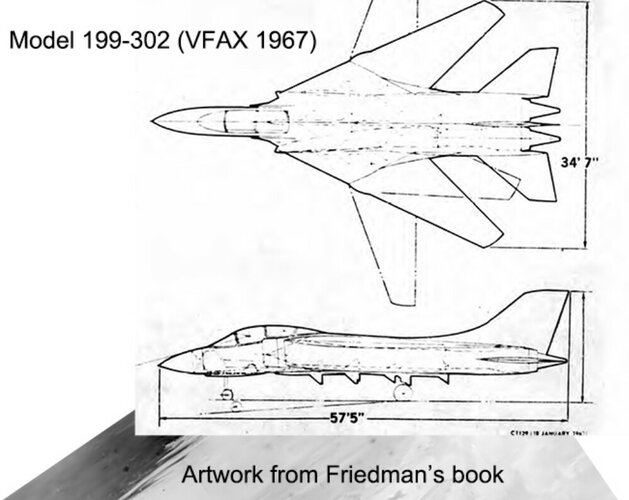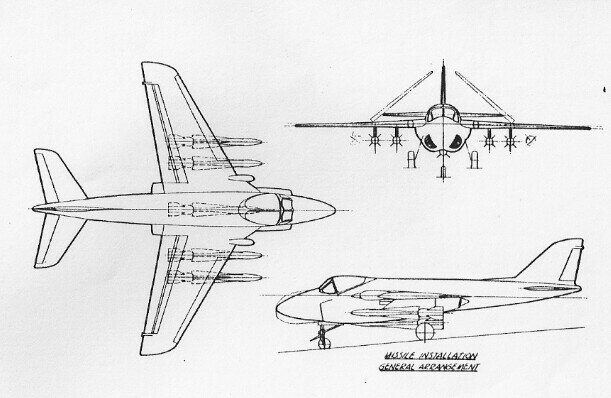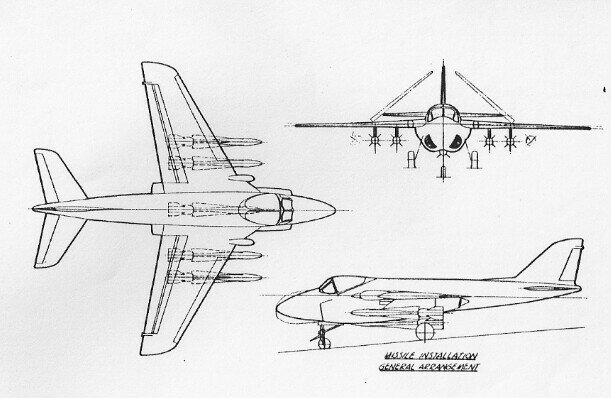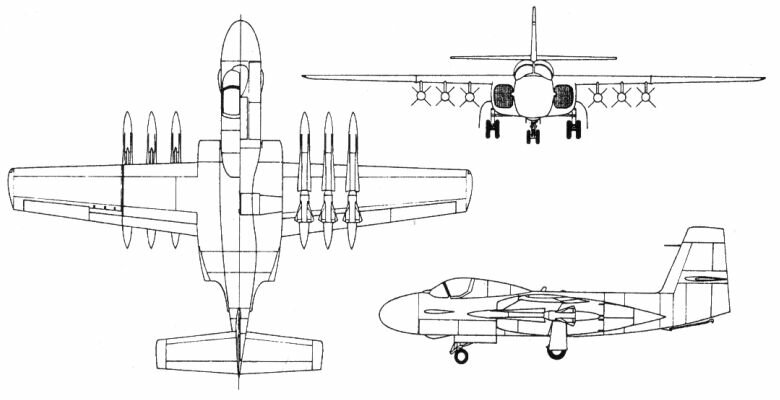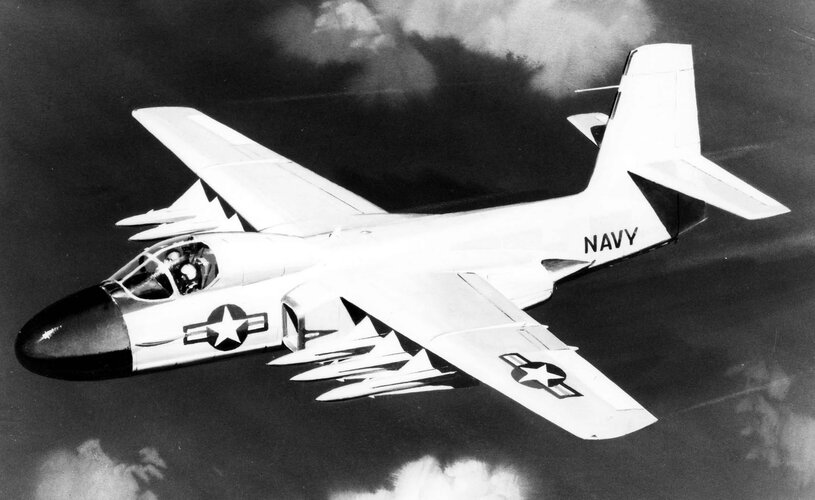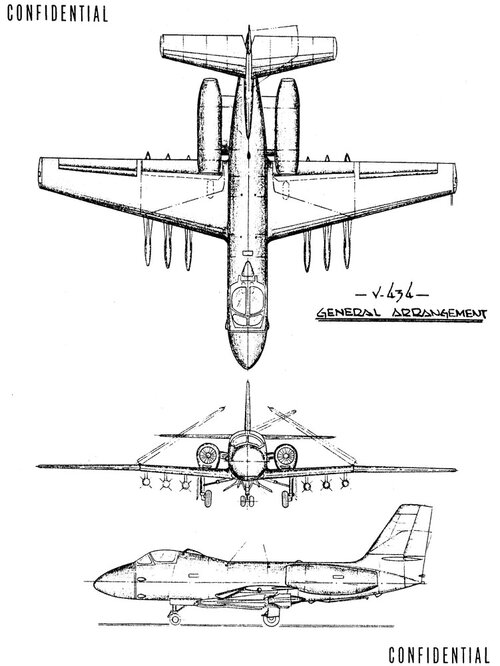As far as I can tell the f-14a had the same avionics as the f-111b and engine, with the airframe being the big difference. This makes it seem like to me, that if the tfx program hadn't happened and the usaf bomber and the us navy interceptor program hadn't been merged, then a f-14 like plane would have been flying by 1965. I'm i right to think that or was there some other technicogical advancement that would have kept the f-14 from flying until later.
You are using an out of date browser. It may not display this or other websites correctly.
You should upgrade or use an alternative browser.
You should upgrade or use an alternative browser.
If no TFX combination would the f-14 been in service sooner.
- Thread starter Cjc
- Start date
pathology_doc
ACCESS: Top Secret
- Joined
- 6 June 2008
- Messages
- 1,561
- Reaction score
- 1,415
IIRC the F-14 arose out of the failure of the F-111B program. If the -111B had been all that was promised (almost completely impossible IRL, but bear with me), there is no need for the -14.
CV12Hornet
ACCESS: Secret
- Joined
- 8 January 2021
- Messages
- 474
- Reaction score
- 1,062
I think you'd get something very similar to the F-14 - most of the pieces were already in place in the early 60s. The Navy wanted a plane that could be both a patrol interceptor and a fighter after the Missileer program; they could leverage work off of the AIM-47 and AAM-N-10 programs for missiles and radar (for the Rapier and Missileer programs, respectively); and the Tomcat's configuration was driven by those requirements, from the between-engines tunnel to the swing wing.
It would probably be closer to a Phantom in turn performance and power, rather than what we actually got, though.
It would probably be closer to a Phantom in turn performance and power, rather than what we actually got, though.
I don't think that the F-14's systems could have been fielded in their final form any time sooner than 1970. While both TF30s and AWG-9/AIM-54 were inherited from the TFX program, it should be remembered, that the variants that made their way into the Tomcat, were much different from their previous iterations.
When it comes to AIM-9, it is a direct descendant of the AN/ASG-18 system, utilized in YF-12A. However, at the time (late 1963), it was still a massive, 2100 lbs heavy system, unsuitable for any fighter but a very heavy interceptor. The AWG-9, as we know it from F-111B, was still a 1760 lbs design, of 1.3 cubic meters volume. During the transition to F-14, additional weight was shed (depending on the source down to 1340 or 1235 lbs), and the volume was reduced to around 0.85 cubic meters, with further functionalities being added (namely AIM-7 and AIM-9 capabilities). Therefore, while the AWG-9 was indeed an "off-the-shelf" system for F-14, only its final iteration was feasible for an air superiority platform.
If we take a look at AIM-54, while it is considered a development of the AIM-47 Falcon, it is a much different missile - it is longer (4.0 m vs 3.81 m), thicker (380 mm vs 330 mm), and considerably heavier (460 kg vs ~360 kg). What is more, the whole Phoenix program was running late compared even to F-111B - the first, unguided launch of AIM-54 took place on 27.04.1966 from A-3 Skywarrior, and the first launch from F-111B did not take place until March 1967. The multitarget capability was not tested until March 1969, and the famous 6-on-6 test was conducted on November 1973, with F-14 production already ramping up. So again, no Phoenix as we know available before 1970.
Finally, one has to consider the Navy requirements. While most people like to consider F-111B a total failure, it wasn't nearly as bad as its reputation suggests. In fact, it can be argued that while overweighted and overpriced, it fulfilled the original TFX requirements, both in terms of weapons capability and the platform itself. It can be also stated that in the fleet air defense role it was actually superior to F-14, with nearly twice as long loitering time. Similarly, while much has been made of its carrier suitability, in terms of the bring-back capability and approach speeds it was better than the Tomcat, and the visibility problems were addressed in the last two pre-production aircraft. The real issue was that the requirements themselves became outdated, and the need for performing "the other fighter missions" became apparent only during the Vietnam war, so around 1965. So from this point of view, again, it is hard to imagine a radically different aircraft from F-111B before the late 60s.
The biggest question, in my opinion, is how the TFX program would have concluded if there was no commonality requirement with USAF. However, even before merging the programs into common TFX, the Navy's requirements were unrealistic. As Tommy Thomason wrote in his excellent F-111B monography, the Navy expected a plane that in comparison to F-4 had significantly longer loiter time, much higher engines' thrust, and carried AWG-9/Phoenix system (with each Phoenix weighing 1000 lbs), all while having 4000 lbs lower gross weight. It is unlikely that even without the burden of USAF requirements, it would be possible for any manufacturer to even come close to fulfilling those objectives. In fact, even the F-14 was not nearly in this ballpark, with 70 700 lbs takeoff weight for fleet air defense mission. As a result, it can be said that any pre-VFX program would likely lead to a significantly overweight and underperforming aircraft, likely unsuitable for any other mission than fleet air defense (which, again, was the main priority of the Navy before 1965).
So to answer the question - I don't think that anything of remotely similar capabilities to F-14 was possible in an earlier timeframe, as all the crucial systems needed additional time to mature. Furthermore, the need for a true, air-superiority platform, which shaped the development of the Tomcat, became apparent only after 1965, so any earlier program would likely end up more similar to F-111B than F-14.
When it comes to AIM-9, it is a direct descendant of the AN/ASG-18 system, utilized in YF-12A. However, at the time (late 1963), it was still a massive, 2100 lbs heavy system, unsuitable for any fighter but a very heavy interceptor. The AWG-9, as we know it from F-111B, was still a 1760 lbs design, of 1.3 cubic meters volume. During the transition to F-14, additional weight was shed (depending on the source down to 1340 or 1235 lbs), and the volume was reduced to around 0.85 cubic meters, with further functionalities being added (namely AIM-7 and AIM-9 capabilities). Therefore, while the AWG-9 was indeed an "off-the-shelf" system for F-14, only its final iteration was feasible for an air superiority platform.
If we take a look at AIM-54, while it is considered a development of the AIM-47 Falcon, it is a much different missile - it is longer (4.0 m vs 3.81 m), thicker (380 mm vs 330 mm), and considerably heavier (460 kg vs ~360 kg). What is more, the whole Phoenix program was running late compared even to F-111B - the first, unguided launch of AIM-54 took place on 27.04.1966 from A-3 Skywarrior, and the first launch from F-111B did not take place until March 1967. The multitarget capability was not tested until March 1969, and the famous 6-on-6 test was conducted on November 1973, with F-14 production already ramping up. So again, no Phoenix as we know available before 1970.
Finally, one has to consider the Navy requirements. While most people like to consider F-111B a total failure, it wasn't nearly as bad as its reputation suggests. In fact, it can be argued that while overweighted and overpriced, it fulfilled the original TFX requirements, both in terms of weapons capability and the platform itself. It can be also stated that in the fleet air defense role it was actually superior to F-14, with nearly twice as long loitering time. Similarly, while much has been made of its carrier suitability, in terms of the bring-back capability and approach speeds it was better than the Tomcat, and the visibility problems were addressed in the last two pre-production aircraft. The real issue was that the requirements themselves became outdated, and the need for performing "the other fighter missions" became apparent only during the Vietnam war, so around 1965. So from this point of view, again, it is hard to imagine a radically different aircraft from F-111B before the late 60s.
The biggest question, in my opinion, is how the TFX program would have concluded if there was no commonality requirement with USAF. However, even before merging the programs into common TFX, the Navy's requirements were unrealistic. As Tommy Thomason wrote in his excellent F-111B monography, the Navy expected a plane that in comparison to F-4 had significantly longer loiter time, much higher engines' thrust, and carried AWG-9/Phoenix system (with each Phoenix weighing 1000 lbs), all while having 4000 lbs lower gross weight. It is unlikely that even without the burden of USAF requirements, it would be possible for any manufacturer to even come close to fulfilling those objectives. In fact, even the F-14 was not nearly in this ballpark, with 70 700 lbs takeoff weight for fleet air defense mission. As a result, it can be said that any pre-VFX program would likely lead to a significantly overweight and underperforming aircraft, likely unsuitable for any other mission than fleet air defense (which, again, was the main priority of the Navy before 1965).
So to answer the question - I don't think that anything of remotely similar capabilities to F-14 was possible in an earlier timeframe, as all the crucial systems needed additional time to mature. Furthermore, the need for a true, air-superiority platform, which shaped the development of the Tomcat, became apparent only after 1965, so any earlier program would likely end up more similar to F-111B than F-14.
- Joined
- 21 May 2006
- Messages
- 2,833
- Reaction score
- 1,915
Tend to agree with your analogy pathology_doc and lolek, as far as I'm aware, it was the direct experience of Grumman's participation in making the F-111 carrier capable, which lead them to design their G-303 much more efficiently. Also keep in mind that the USN itself incorporated the lessons and failures of the TFX/F-111B into it's VFX requirements/specifications.IIRC the F-14 arose out of the failure of the F-111B program. If the -111B had been all that was promised (almost completely impossible IRL, but bear with me), there is no need for the -14.
Maybe consider as an intermedium something more akin to the Grumman F-111 CWIP? For I'm admit, had the TFX program have occured, it still would have been a significant sized and weighted design, given that that was the upwards trend of both the USAF and USN.......
Or what about something like the McDonnell Douglas Model 199-302 - a seemingly advanced outgrowth of the then F-4 Phantom II, incorporating the then trending variable-geometry wings, perhaps Rolls-Royce Spey (Allison TF41) afterburning turbofans, .......
As for the FAD requirements of the USN, I'd consider the adoption of the proposed Grumman Model 128E proposal - an A-6 Intruder with non-afterburning TF30 turbofans, AIM-47 and AN/ASG-18 (which still might be developed into akin to AIM-54 and AWG-9)....this would not just be more affordable, but offer more carrier on-board compatibility.
(Note: I appreciate that the use of two different designs for two different roles will have an impact of a carriers capacity and maintenance efforts, but I also appreciate that just like the F-111B, it's requirements to be a jack of all trades meant it realistically became the master of none.)
Regards
Pioneer
Attachments
Last edited:
apparition13
I really should change my personal text
- Joined
- 27 January 2017
- Messages
- 535
- Reaction score
- 958
If no TFX, then the USAF and USN get their preferred aircraft. The USAF gets it's swing wing strike aircraft, and the USN gets it's Missileer. Which means a 12 aircraft squadron of Eagle armed CAP aircraft could be deployed to every attack carrier, including the Essexes.
What they would probably want next would be something that could replace everything but the A-6 and F6D. It wouldn't need the big radar and extreme long range missiles of the F-14, but it would need to be light attack, strike escort, and deck launched intercept capable. Taking the lessons of Viet Nam on board might result in something that could do the same mission set the F-18 did later. Not an actual F-18 obviously, but something with similar performance, though hopefully with better range.
A Missileer replacement might be due by 1980 or so, which might result in a super-maneuverable, supercruising fighter, which is what was on tap in the 70s and early 80s before stealth took precedence later in the 80s.
What they would probably want next would be something that could replace everything but the A-6 and F6D. It wouldn't need the big radar and extreme long range missiles of the F-14, but it would need to be light attack, strike escort, and deck launched intercept capable. Taking the lessons of Viet Nam on board might result in something that could do the same mission set the F-18 did later. Not an actual F-18 obviously, but something with similar performance, though hopefully with better range.
A Missileer replacement might be due by 1980 or so, which might result in a super-maneuverable, supercruising fighter, which is what was on tap in the 70s and early 80s before stealth took precedence later in the 80s.
CV12Hornet
ACCESS: Secret
- Joined
- 8 January 2021
- Messages
- 474
- Reaction score
- 1,062
After looking into all the sources I have available, I do tentatively agree with the idea that the Missileer would go forward. The timings are all over the place, and people keep saying different things about why it was cancelled, but aside from putting the cancellation a year early that oral history in the F6D thread lines up the best. Basically, it was put on hold in late 1960 for the Kennedy administration to decide what to do with it, McNamara looked at it and OR.183 and decided in February 1961 to merge the two requirements, and the Missileer was cancelled a few months later.
This might kill the Phantom for the Navy. Reading between the lines of some Congressional testimony from a budget perspective it seems like the choice came down to Missileers or Phantoms, not both.
As far as something to complement the Missileer and Intruder, I don't think the Navy will go for another fighter. Their studies on a new light attacker indicated supersonic performance was not compatible with that role, and as mentioned if they can't afford the Phantom they can't afford another fighter; they'll buy the Corsair and that'll be that until Vietnam happens and shakes them out of that mindset. I think there's enough time and money to develop both that fighter and the Missileer replacement.
This might kill the Phantom for the Navy. Reading between the lines of some Congressional testimony from a budget perspective it seems like the choice came down to Missileers or Phantoms, not both.
As far as something to complement the Missileer and Intruder, I don't think the Navy will go for another fighter. Their studies on a new light attacker indicated supersonic performance was not compatible with that role, and as mentioned if they can't afford the Phantom they can't afford another fighter; they'll buy the Corsair and that'll be that until Vietnam happens and shakes them out of that mindset. I think there's enough time and money to develop both that fighter and the Missileer replacement.
BlackBat242
OK, I changed my personal text ;)
- Joined
- 10 April 2013
- Messages
- 1,205
- Reaction score
- 3,302
That's really surprising, as the Phantom program was seeing deliveries of production F4H-1F (F-4A) Phantoms in 1960 BEFORE the Missileer program was put on hold!This might kill the Phantom for the Navy. Reading between the lines of some Congressional testimony from a budget perspective it seems like the choice came down to Missileers or Phantoms, not both.
The USN had always planned procurement of BOTH types, and Congress had approved production and procurement of the Phantom before the F6D program was anywhere near its final go/no-go decision point.
And seeing as the USN and Congress went ahead with the F-111B for some years even though the Phantom was flooding into the fleet makes your contention seem rather questionable.
CV12Hornet
ACCESS: Secret
- Joined
- 8 January 2021
- Messages
- 474
- Reaction score
- 1,062
You're probably right, I probably was reading too much into the Congressional testimony. Which really just solidifies the case for the Corsair over any sort of multirole fighter to fill the light attack role.That's really surprising, as the Phantom program was seeing deliveries of production F4H-1F (F-4A) Phantoms in 1960 BEFORE the Missileer program was put on hold!
The USN had always planned procurement of BOTH types, and Congress had approved production and procurement of the Phantom before the F6D program was anywhere near its final go/no-go decision point.
And seeing as the USN and Congress went ahead with the F-111B for some years even though the Phantom was flooding into the fleet makes your contention seem rather questionable.
The Hornet-like fighter apparition proposed thus pretty much has to be a post-Vietnam proposition, in which case it's probably going to find the Navy caught between it and the proposed Missileer replacement and I think we all know which one the Navy would pick.
Kat Tsun
eeeeeeeeeeeeeee
- Joined
- 16 June 2013
- Messages
- 1,200
- Reaction score
- 1,531
As far as I can tell the f-14a had the same avionics as the f-111b and engine, with the airframe being the big difference. This makes it seem like to me, that if the tfx program hadn't happened and the usaf bomber and the us navy interceptor program hadn't been merged, then a f-14 like plane would have been flying by 1965. I'm i right to think that or was there some other technicogical advancement that would have kept the f-14 from flying until later.
It wouldn't happen like that at all lol.
TFX happened because USAF and USN decided/were told by DOD that it would be better off pooling resources on a single tactical aircraft than single development of two separate fighter and fighter-bomber programs. At the time this made sense, Phantom was the most obvious and recent historical example of such a thing, but if the Congress and DOD had to pick one, the USAF would win that fight.
Why? Because the USN already had Phantom, which was good enough for the job of air defense for the time being, and the USAF had the then-ancient Thunderchiefs lol. Better to replace the Thunderchief with a decent, modern strike aircraft than to give the Navy a brand new aircraft when they just bought the latest and greatest fleet air defense fighter that exists.
Without that initial failure of TFX, the concepts either turn towards rapidly outdated aircraft or the adaptation of future existing fighters like the F-15 to the needs of the Fleet, instead. That might go as well as TFX, or it might be another Phantom and put another nail in the Fleet air development corpus, who knows. TFX was the lesson needed to show the Congress and DOD that joint programs of wildly separate services aren't easily squared circles like Phantom was, which paved the way for Tomcat.
If the Navy were allowed to buy its own plane in 1963 it would just be a fat A-6 with half a dozen, significantly worse than the actual thing, Phoenix-alikes under its wings, so it would be a useless fighter but a decent missileslinger that hangs out next to the E-2s. Assuming Eagle would ever be updated with the INS and active radar homing of the Phoenix, it could potentially even be a decent missile in its own right.
They'd have that thing around until the 1980's at least, since Vietnam would sap a lot of the political willpower to purchase new fighters for a while, but maybe when developing VFAX in the '70's to replace the Phantom and A-7/A-4 with a single multipurpose fighter, they'd decide to purchase Super Hornets or something for the fleet air defense fighter job, and Iran would drive F-15As. Or maybe the USN would already have a F-15N or something, in the aftermath of the highly successful USAF procurement scheme of the supersonic F-111A towards the similarly successful Phantom replacement of F-15.
So the US Navy would leapfrog its crazy quilt carrier wings of the Weinberger era with a modernized and streamlined Cheney era wing of "heavy" and "light" multipurpose fighters instead.
Last edited:
CV12Hornet
ACCESS: Secret
- Joined
- 8 January 2021
- Messages
- 474
- Reaction score
- 1,062
Grumman's entry into the competition that produced the F6D was indeed a modified Intruder airframe.Now that's one hell of an idea - could the Intruder airframe be adapted to the Missileer role ? Or the EA-6B four-seat variant ?
Yes. And didn't Douglas proposed a modified Skywarrior ? another decent idea. And I swear NAA tried to push a Vigilante, too, although it couldn't do 100% of the job.
(Fighters over the fleet - I presume ? Norman Friedman ?)
(Fighters over the fleet - I presume ? Norman Friedman ?)
Last edited:
BlackBat242
OK, I changed my personal text ;)
- Joined
- 10 April 2013
- Messages
- 1,205
- Reaction score
- 3,302
SSgtC
ACCESS: Top Secret
- Joined
- 13 July 2020
- Messages
- 1,214
- Reaction score
- 2,785
I just want to point out, this assertion is utterly, and completely false. The F-105 had its maiden flight in October, 1955. Less than 3 years before the Phantom made its maiden flight. Hell, the Thud was in production up through 1964! It was hardly "ancient." In fact, it was arguably the most modern tactical bomber the USAF had in its inventory until at least halfway through Vietnam (and the Phantom superseding it in the strike role). And even then, the Phantom only replaced it because it had a hot production line and could replace losses, while the Thunderchief line had been closed a year before the US decided to stick its dick into the meatgrinder that was Vietnam. By the time losses had become critical for the Thud and the decision was made to withdraw it from Vietnam, the line had been closed for six years. And despite all that, F-105s still flew over half of all bombing missions over Vietnam.Why? Because the USN already had Phantom, which was good enough for the job of air defense for the time being, and the USAF had the then-ancient Thunderchiefs lol. Better to replace the Thunderchief with a decent, modern strike aircraft than to give the Navy a brand new aircraft when they just bought the latest and greatest fleet air defense fighter that exists.
Last edited:
pathology_doc
ACCESS: Top Secret
- Joined
- 6 June 2008
- Messages
- 1,561
- Reaction score
- 1,415
It's like the secret great grand-daddy of an A-10 Warthog bumped ugly with an Intruder, fed the kid steroids and strapped as many long-range AAMs as it could carry to the wings.Vought V-434 :
You'd think the Vigilante would be a good contender for the role. The airframe existed in metal and was a known quantity. Where did it fall down?And I swear NAA tried to push a Vigilante, too, although it couldn't do 100% of the job.
It's like the secret great grand-daddy of an A-10 Warthog bumped ugly with an Intruder, fed the kid steroids and strapped as many long-range AAMs as it could carry to the wings.Vought V-434 :
You'd think the Vigilante would be a good contender for the role. The airframe existed in metal and was a known quantity. Where did it fall down?And I swear NAA tried to push a Vigilante, too, although it couldn't do 100% of the job.
Loitering time on station, a distance from the carrier - waiting for swarms of Soviet Navy bombers with aSh missiles under their wings. The Vigilante being supersonic was not good enough at flying in circles subsonically. Skywarriors and Intruders on the contrary... they got tanker variants.
- Joined
- 13 August 2007
- Messages
- 7,869
- Reaction score
- 8,970
The Navy's Alternatives To The F-14 Tomcat Were A Fascinating Mix Of Good Ideas. Some Of Them French
View: https://www.youtube.com/watch?v=Z0e4m5fQGNk
Scott Kenny
ACCESS: Above Top Secret
- Joined
- 15 May 2023
- Messages
- 8,772
- Reaction score
- 9,635
To answer the original question, no. TFX issues led to the F-14 as we know it today.
If no TFX, the USN would very likely have gone with a Missileer of some kind. My personal preference is the A-6 version, not the Douglas one, if only for aesthetics.
If no TFX, the USN would very likely have gone with a Missileer of some kind. My personal preference is the A-6 version, not the Douglas one, if only for aesthetics.
OMG, what a zinger. "The USN saw the McDonnell proposal as more of an intellectual exercise. McDonnell offered this to the Fleet Air Arm, given that service's preference for intellectual exercises over actual aircraft in this time period."The Navy's Alternatives To The F-14 Tomcat Were A Fascinating Mix Of Good Ideas. Some Of Them French
View: https://www.youtube.com/watch?v=Z0e4m5fQGNk
Rule of cool
ACCESS: Top Secret
- Joined
- 16 January 2024
- Messages
- 1,133
- Reaction score
- 1,423
I doubt the USN would revert to a concept they cancelled in 1961. To me the Missileer-F111B-F14 is the evolution of airframe and electronics; in 1959 the radar and missiles needed a bomber sized aircraft to tote them, by 1962 that bomber could go mach 2 and by 1967 the evolved systems were able to fit into a big fighter.
Without the TFX I suspect the Navy will put the systems into some big mach 2 aircraft, as that was the state of the art in 1962. However I doubt it would be as good as the F14 because by 1967 Rolling Thunder had been going for 2 years and the F14s design called for the ability to beat the Mig 17, Mig 19 and later the Mig 21. An aircraft with its design frozen prior to 1965 will have none of those design considerations and will likely be fast but as agile as a bus.
Without the TFX I suspect the Navy will put the systems into some big mach 2 aircraft, as that was the state of the art in 1962. However I doubt it would be as good as the F14 because by 1967 Rolling Thunder had been going for 2 years and the F14s design called for the ability to beat the Mig 17, Mig 19 and later the Mig 21. An aircraft with its design frozen prior to 1965 will have none of those design considerations and will likely be fast but as agile as a bus.
Scott Kenny
ACCESS: Above Top Secret
- Joined
- 15 May 2023
- Messages
- 8,772
- Reaction score
- 9,635
Yeah, it'd likely be something like a fighterized A-5 Vigilante. Or the F111B itself.I doubt the USN would revert to a concept they cancelled in 1961. To me the Missileer-F111B-F14 is the evolution of airframe and electronics; in 1959 the radar and missiles needed a bomber sized aircraft to tote them, by 1962 that bomber could go mach 2 and by 1967 the evolved systems were able to fit into a big fighter.
Without the TFX I suspect the Navy will put the systems into some big mach 2 aircraft, as that was the state of the art in 1962. However I doubt it would be as good as the F14 because by 1967 Rolling Thunder had been going for 2 years and the F14s design called for the ability to beat the Mig 17, Mig 19 and later the Mig 21. An aircraft with its design frozen prior to 1965 will have none of those design considerations and will likely be fast but as agile as a bus.
Good top speed, good loiter, marginal Basic Fighter Maneuverability, no gun.
Without the delays and resistance from the USN about the F111B, we would not have seen a gun armed maneuverable fighter.
Remember, the USN never did install guns on their Phantoms!
Similar threads
-
what if the US Navy went with the F-15
- Started by helmutkohl
- Replies: 4
-
Long term effects of an F-104 scandal
- Started by Lascaris
- Replies: 47
-
What if Cheney never became SecDef and VP? what would change?
- Started by helmutkohl
- Replies: 43
-


